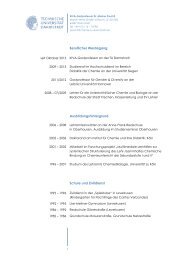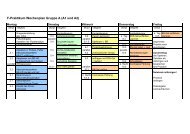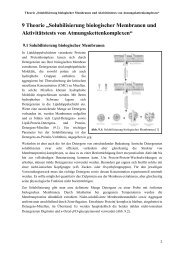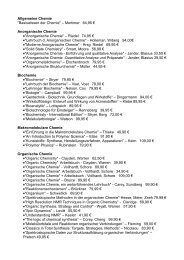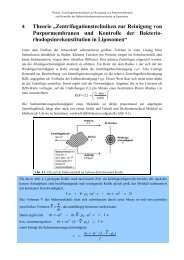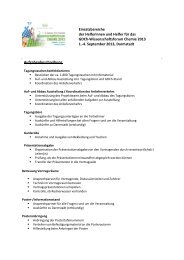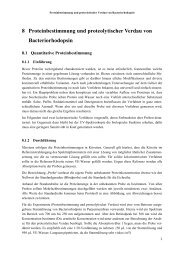Molecular Dynamic Simulation of united atom liquid n-hexane
Molecular Dynamic Simulation of united atom liquid n-hexane
Molecular Dynamic Simulation of united atom liquid n-hexane
You also want an ePaper? Increase the reach of your titles
YUMPU automatically turns print PDFs into web optimized ePapers that Google loves.
THEORETICAL PHYSICAL CHEMISTRY TU DARMSTADT<br />
3. <strong>Molecular</strong> dynamics simulation<br />
NOTICE: Use mkmdinput to make an input file. For all the molecular dynamics here, cut<strong>of</strong>f is<br />
1.1nm, neighbor list cut<strong>of</strong>f 1.2nm, verbose = 5. You may need copy files listed below from<br />
/data/students/exercises/prac4: <strong>hexane</strong>-1.tp, <strong>hexane</strong>-1.co, tor1.dat , tor2.dat, tor3.dat, merge.csh,<br />
average.cpp<br />
a. Create a box <strong>of</strong> equilibrated <strong>liquid</strong> n-<strong>hexane</strong> starting from a one molecule coordinate file<br />
The coordinate file <strong>hexane</strong>-1.co (copy from /data/home/fleroy/students/exercises/prac4) gives the<br />
coordinates <strong>of</strong> one n-<strong>hexane</strong> molecule. Now place 100 molecules into a box with the tool position.<br />
Before you run the program think about the box size. The molecules should not overlap, but the system<br />
should neither be too dilute. To obtain a reasonable box size for 100 n-<strong>hexane</strong> molecules, you can use<br />
density <strong>of</strong> <strong>liquid</strong> n-<strong>hexane</strong> at normal conditions to calculate it (656kg/mol, 298K). The calculated cubic<br />
box dimension along one direction is around 2.8nm.<br />
The system has to be equilibrated. This is done in two steps: in the first run the internal structure <strong>of</strong> the<br />
molecule should relax, so that strong deviations <strong>of</strong> internal degrees <strong>of</strong> freedom (e.g. angles) vanish,<br />
and overlaps <strong>of</strong> <strong>atom</strong>s are removed. In the second step the density has to be equilibrated. The system<br />
runs until the density has reached its final value.<br />
For equilibration, in our case, both NVT and NPT simulation are employed.<br />
1). NVT: first, you should remove isotropic pressure coupling in the input file. Run the simulation<br />
50000 steps with time-step (2fs) and temperature coupling time (300K, 0.2ps).<br />
2). NPT: Now the density <strong>of</strong> the system has to be equilibrated using isotropic pressure control<br />
(101.3 0 1.0e-6 5). Start the simulation using the final output coordinates from the last simulation as<br />
the input coordinates. Another 50000 steps with the same time-step and the same temperature coupling<br />
time is run.<br />
3). NPT: equilibrate the system again with NPT but with a shorter pressure coupling time (101.3 0<br />
1.0e-6 2). Start the simulation using the final output coordinates from the last simulation as the input<br />
coordinates. Another 300000 steps (every 300 timestep is suggested for output) with the same timestep<br />
and the same temperature coupling time is run.<br />
4). Monitor the density and temperature with plot_values, determing if it has equilibrated (exp.<br />
656kg/mol, 298K). With the programs jmol or vmd, you can get an impression <strong>of</strong> the spatial structure<br />
<strong>of</strong> n-<strong>hexane</strong>. But before that, you need get a .xyz file using:<br />
yasp2xyz < md.co > md.xyz<br />
b. Production simulation<br />
Run a long simulation (about 100000 steps) using the final output coordinates from the last simulation<br />
as the input coordinates. Use the last input file, except changing the simulation steps (keep the other<br />
5



